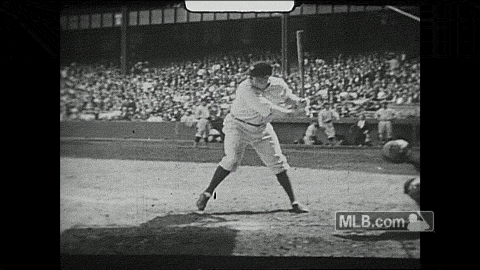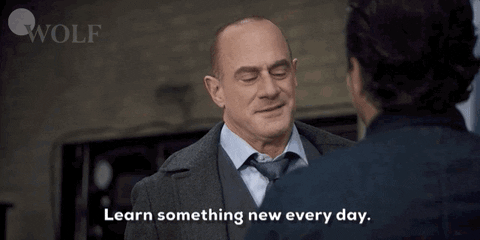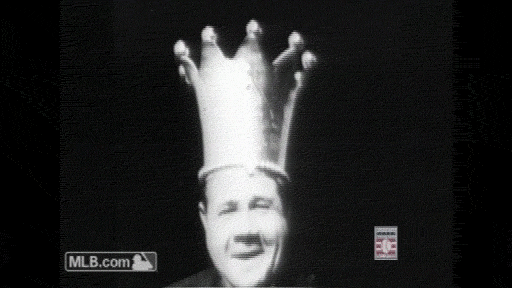Lawyers should strategically use content to signal to clients and referral sources the kinds of legal matters they want to handle
2022 marks the 90-year anniversary of baseball legend Babe Ruth’s called shot, an act that has captivated generations of sports fans and transcended sports.
But more importantly for you and your colleagues, Babe Ruth’s called shot provides a lesson for lawyers wanting to continue to build their book of business as they expand their practice or move into a new practice or niche.
The legend of Babe Ruth’s called shot

During the third game of the 1932 World Series between the New York Yankees and the Chicago Cubs, which took place on Oct. 1, 1932, in Wrigley Field, Babe Ruth was getting heckled.
The hecklers might have been Chicago fans sitting in the stands. They might have been Cubs players sitting in the dugout. They might even have been Cubs players on the field.
Whoever they were, they were apparently getting under Ruth’s skin. The tension was particularly high during his at-bat in the top of the fifth inning.
During his at-bat, he started exchanging words with Cubs players. After the first strike in his at-bat, a called strike, Ruth exchanged more words with Cubs players and held up a single finger to the Cubs’ dugout. (It’s not clear which single finger he held up.)
After taking two balls, another strike was called. Ruth then pointed with his right hand to someone or something. Maybe it was the Cubs’ pitcher. Maybe it was the Cubs’ dugout. Or maybe it was the flagpole beyond center field.
That gesture would soon go down in history.
That’s because on the very next pitch, Ruth hit a home run so far that it landed outside the stadium. The legend of his called shot was born.
Never before (or since) did a baseball player have the audacity to, allegedly, suggest he would hit a home run on the next pitch he faced and then actually go ahead and do it.
Since the event happened before every baseball game was televised with the help of numerous cameras, and before the fans sitting in the stands had cameras in their pockets practically as powerful as those used by the professionals filming the games, there are conflicting reports about what actually happened.
In February 2014, the New York Post reported on a book that seemed to debunk the legend of the called shot.
In February 2020, Major League Baseball looked at the called shot and concluded that while Ruth definitely gestured, it was not clear what he was indicating through that gesture.
But in October 2020, Major League Baseball reported that an author working on a book about Lou Gehrig, one of Ruth’s teammates, found audio of an interview Gehrig gave in 1932 that confirmed Ruth called his shot.
The key lesson lawyers and law firms can learn from Babe Ruth’s called shot

What does Babe Ruth’s called shot have to do with lawyers and law firms?
A lot, actually. Lawyers and their law firms should use marketing and business development content, like thought-leadership content, to call their shot like Babe Ruth.
They can use the content they create to begin directing their legal practice toward an expanded practice, a new practice, a niche within their current practice, or toward a new audience they hadn’t previously marketed to.
By crafting content that strategically focuses on certain aspects of that new legal practice or niche, or that focuses on issues relevant to that new target audience, lawyers and law firms can call their shot like Babe Ruth and show past, current, and prospective clients and referral sources the (new) kinds of legal matters they are handling or want to be handling.
For example, let’s say you are a white-collar criminal litigator with a general white-collar criminal legal practice. But you want to handle cryptocurrency fraud cases. Or federal bribery cases.
If you start writing blog posts and articles about cryptocurrency fraud or federal bribery prosecutions, or about speeches given by prosecutors regarding cryptocurrency fraud or federal bribery, clients and referral sources will begin to see you as someone who is knowledgeable about those topics and who must be actively practicing in those areas of the law. After all, why else would you be writing content about them if you weren’t actively practicing in them?
Here’s another example. Let’s say you are a corporate lawyer with a practice focused on private equity. You see an opportunity to be the leading private equity lawyer serving your state’s manufacturing industry. You want to be known as THE private equity lawyer investors and manufacturers come to when they want to do deals in that industry.
If you begin writing a blog or articles focused on what’s happening in your state’s manufacturing industry, whether it be business and economic conditions, industry trends, recent deals, political headwinds, or other topics, clients and referral sources will begin to see you as someone knowledgeable about the industry and the business of manufacturing.
Once you are perceived as an authority thanks to the content you’ve published, opportunities to work on client matters in those areas will likely soon follow. And those opportunities will bring with them more knowledge you will be able to convey through your blog posts and articles that will boost your standing as a “go-to” lawyer in your desired area.
The content/client matter flywheel will keep spinning as your content creation fuels the market’s perception of your knowledge and experience, which leads to more matters you bring in and work on, which leads to more interesting and in-the-know topics you will be writing about, which leads to an increased favorable perception of your knowledge and experience, which leads to more matters you bring in and work on, and so on.
A Subtle and Efficient Way to Announce to the World

Using thought-leadership content like blog posts and articles to call your shot and direct your legal practice is more subtle and efficient than other methods lawyers and law firms might use to announce new practices or new niches within their current practices.
You won’t need to take out ads in bar association publications. Or send postcards or fliers announcing the change. Or send a blast promotional email that provides no value to its recipients.
For the same cost you already incur (in time, money, or both) when you write blog posts and articles, you will be able to subtly tell the world about the direction your practice is going. The valuable insights you will consistently provide in your blog posts and articles about your changing practice area are more likely to be consumed, absorbed, and remembered by your target audience than ads or sales materials.
The people consuming your content will slowly notice your consistent focus on particular legal topics. They’ll recognize that you should be someone they call regarding legal or business issues related to the topics you are covering in your marketing and business development content.
Equally as important, if for some reason you are unable to get any traction with your practice pivot, or your attempt to enter a niche goes nowhere, there’s minimal wasted effort, time, or money. You can simply pivot again toward a new direction in your practice, using content as the tip of that spear. No one will be the wiser. Few people, if any, will wonder why you aren’t covering the topics you were previously covering in your marketing and business development content. And that older content can stay online as proof that you are knowledgeable about the area of law you are pivoting away from in case there are clients looking for help in that area.
Call your shot like the Great Bambino

Just like Babe Ruth called his shot 90 years ago, you should do the same when you are expanding or pivoting your legal practice.
Call your shot by showing clients and referral sources, through the knowledge and wisdom you’re dispensing via your blog posts and articles—or videos, podcasts, and other forms of content—what your legal practice is and where it is heading.
Your attempts to call your shot will not carry the same mythical status Babe Ruth’s called shot carries. But they could very well lead to the same outcome for your book-of-business-building efforts: a home run.
Thinking about bringing on an outside writer to help you call your shot with content? Click here to schedule a 30-minute Content Strategy Audit to learn if collaborating with an outside writer is the right move for you and your firm.

